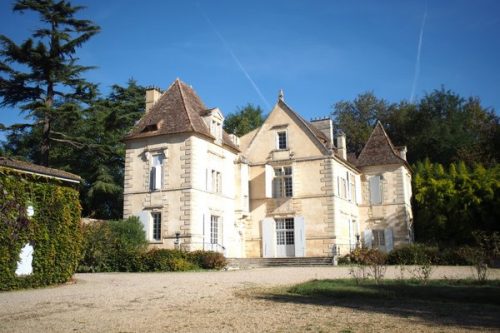
Véronique Cochran is the proprietor of Château Falfas, which she runs with her husband John. This estate is beautifully situated in the Côtes de Bourg, with 20 hectares of vines planted on gravel, clay and limestone soils (with limestone bedrock), running down to the Gironde esturary on a gentle south-facing slope. The dominant feature of the soil, though, is the clay, which can be quite deep. The nearest village, Bayon, is where the Garonne and Dordogne rivers meet and the estuary begins. ‘It is like a little sea, with tides,’ says Veronique. ‘Every 6 hours oceanic air comes in the vineyards breathe it.’ There is also a 15 hectare woodland on the property, which she describes as a ‘treasure.’

There are two main stories about this estate that bring it into the Alternative Bordeaux story. The first is that this is a great example of a good terroir in an unfashionable part of the region, capable of making excellent wines even though traditionally wines from here don’t sell for much. The second is that Falfas is one of the pioneers of biodynamics in France. Since 1989 the vineyards here have been farmed biodynamically.


The chateau itself was built in 1612, and the cellar was constructed in the late 17th century. Her mother and father had a vineyard in Montreuil-Bellay in Saumur (Loire), and her father, François Bouchet, was one of the first to apply biodynamics to vineyards (his book, Biodynamic Agriculture: how to apply it to vineyards, is a standard in the field). He died in 2005, but her brother Matthieu Bouchet works as a biodynamic consultant, and counts Château Palmer as one of his clients. François consulted for Château Pontet Canet when they made the transition.
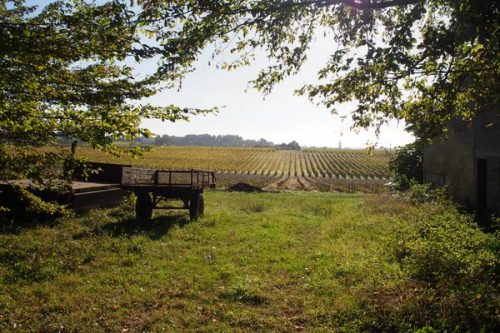
Veronique’s brother runs the family estate in Saumur and this has been farmed biodynamically since the 1960s, which makes it one of the earliest biodynamic wine estates in the world. She grew up there, but was more interested in art than wine. She studied art and movement in Paris, where she met John, who was an American lawyer working there. Both changed careers to move to Bordeaux to run a wine estate. They arrived in 1988 and looked at several properties. ‘This place touched our hearts,’ says Veronique. ‘It’s a special place, serene and discrete. The situation is quite special.’
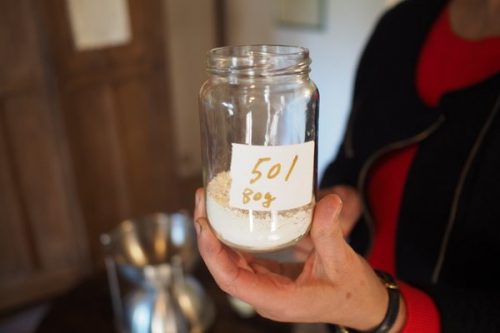
‘I said it would be run biodynamically,’ she said. ‘At first he wasn’t convinced, but I had the energy to do it and it wasn’t long until he was convinced,’ recalls Veronique. ‘Rapidly he saw it was a very global approach; something very deep, permitting the expression of place and respecting the harmony of plants and soil. We built it with our feet on the ground and our heads looking at the cosmos.’

The Cochrans have worked closely with Biodyvin. She says that research, commissioned by Biodyvin and carried out by Philippe Olivier Coulomb in the southern Rhône, shows that biodynamic farming results in thicker skinned grapes. ‘I believe in my fruit,’ she says. ‘I know it is strong enough to be balanced in the fermentation process without sulfur dioxide additions.’ After harvest, fermentation is with wild yeasts. Veronique makes a pied de cuve each year but says she never needs it. However, she does add sulfites before bottling. ‘I’m not a partisan of low sulphur. It permits the wines to travel and to be stable.’


‘I’m convinced that biodynamics is agriculture for the future,’ says Véronique. ‘I see more and more demand for it. Some people are frightened by things they can’t understand, and things that are not visible, but I believe that life is not visible.’
Three cuvées are made. The young vines see no oak; Château Falfas gets a year in barrel; and the old vine reserve gets 20 months in new oak. ‘The barrel is a new period of ripeness for the wine,’ she says. ‘It is not adding anything; just time.’ Production is 80-90 000 bottles per year.
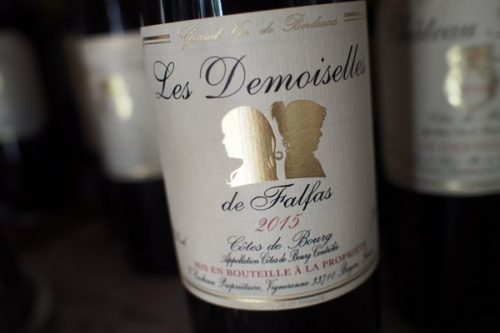
THE WINES
Château Falfas Les Desmoiselles de Falfas Rosé 2014 Bordeaux
Saignée rosé. Sappy and detailed with a nice spiciness. Some apple notes, with cherries, spice and herbs. A bit of animal wildness, too, with a strongly savoury character. Gastronomic.
Château Falfas Les Desmoiselles 2015 Côtes de Bourg, Bordeaux
When it’s at specific gravity of 1000 the wine is taken out of the vat and finished in the vat without the skins and the seeds. Add some sulphites (tiny amount, gas form) just after malolactic. Total is 45 ppm. Very supple and fresh with lovely pure fresh cherry and raspberry fruits. So supple, fresh and delicious with real elegance and lovely pure direct fresh fruit and a subtle chalky edge. Delicious. 91/100
Château Falfas 2010 Côtes de Bourg, Bordeaux
55% Merlot, 30% Cab Sauvignon, 10% Cabernet Franc, 5% Malbec. The first vintage I vinified myself because my husband died in spring 2010. Supple, sweet cherry fruits with a bit offresh blackcurrant. Juicy and sappy with a bit of grip. Fresh and leafy with a bright personality and good acidity. Vibrant and vital with a lovely green edge. Lovely digestible wine. 92/100
Château Falfas 2011 Côtes de Bourg, Bordeaux
Grippy, dense and structured with firm, fresh, gravelly blackcurrant and blackberry fruit. Lovely acidity here and some greenness, integrated into the savoury, tightwound fruit. Savoury, structural and dense, this is a very gastronomic wine. Chunky but still has harmony. 91/100
Château Falfas 2012 Côtes de Bourg, Bordeaux
Pure, sinewy, dense blackberry and blackcurrant fruit with good structure and acidity. There’s a lovely precision to this wine, with some fruit purity. Peppery and dense with real focus and depth. Has a lovely harmony to it. There’s a generosity to this wine with some sweetness to the fruit, but also good structure. A lovely wine with a long future ahead of it. 94/100
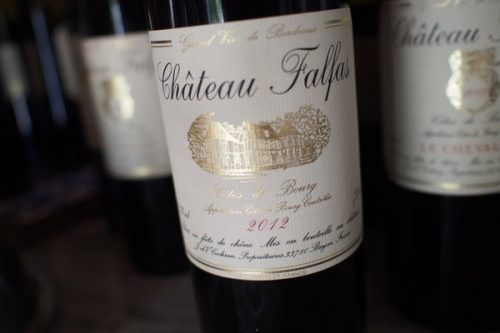
Château Falfas Le Chevalier 2008 Côtes de Bourg, Bordeaux
75 year old vines, mostly Cabernet Sauvignon, very small grapes and low yield. Aged 22 months in new oak barrels. Sweet vanilla oak on the nose. Fresh red and black fruits palate with a strong overlay of new oak, with coconut and vanilla notes sticking out a bit. 88/100
Château Falfas Le Chevalier 2009 Côtes de Bourg, Bordeaux
Supple red berry and blackberry fruit here. Fresh with some fruit sweetness, and also some spicy, cedary oak. Appealing mid weight fruit but the oak isn’t quite fully integrated yet. Fine-grained tannic structure suggests a harmony to come. 89/100
Château Falfas Le Chevalier 2011 Côtes de Bourg, Bordeaux
‘I changed from the Radoux barrels because they gave a lot of presence of oak, so I only now work with Raymond, with medium toast,’ says Veronique Cochran. ‘I am trying to make sure the barrel is a prop to lift the wine and not to cover it.’ Supple and finely spiced with some peppery detail, good acidity and nice tannins. Quite savoury and cedary with lots of presence but also good balance. Still quite tannic and worth waiting a few years for it to peak. 91/100
Château Falfas Le Chevalier 2012 Côtes de Bourg, Bordeaux
Fresh, direct and supple with good acidity and structure as well as fresh red cherry and blackcurrant fruit. Supple, juicy and yet with some savoury seriousness. This is quite tannic, shows some cedary oak at the moment, and it has lots of potential for development. There’s a finesse here as well as sternness. Lovely wine. 93/100